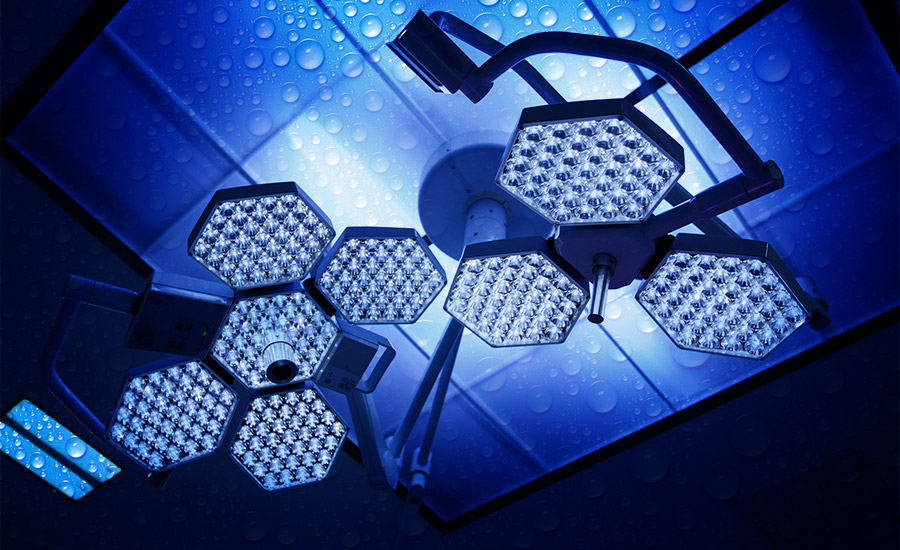The case for humidification and dehumidification in hospital procedure rooms — particularly operating rooms — is a neverending debate of have’s and have-not’s. Many acute care facilities see it as cost-prohibitive to install a complete humidification system in certain climates only to use it for one short week a year. And yet a hospital’s most critical areas, including operating and isolation rooms, require precise humidity control year round regardless of outside temperature and humidity conditions.
Per NFPA 99, the National Healthcare Facilities Code, humidity shall be maintained between 30% and 60%. This range is the topic of debate — ASHRAE, ASHE, and other health care governing agencies say a lower rh of 20% can still meet the needs of most of today’s procedure rooms. Additionally, because global weather patterns are evolving to include more droughts, extreme colds, and storms, specifying engineers are finding they can rely less and less on historical weather data to determine the need for humidification in acute facility design. Together, these issues have led to the inclusion of humidification systems in most hospitals as a best practice.
Humidification Considerations in Today’s Health care Facilities
When determining what role humidification should play in an acute care facility design, you have a number of important considerations, including: understanding applicable codes and standards, implementation strategies for both humidification and dehumidification, and the impact of humidification on hospital certification. These considerations will dictate what type of humidity control strategy is needed and will help establish system design and operational parameters.
Consideration #1: Governing Codes, Standards, and Best Practices
The humidification debate is overshadowed by national, state, and local edicts. Depending on the facility function, a variety of codes, standards, and other guidelines exist.
On a national level, the following codes and standards require compliance.
- NFPA 99: Health Care Facilities Code requires rh to be between 30% and 60%.
- ASHRAE Standard 170 used to be the same as NFPA 99, but recent recommendations are changing this standard to widen the allowed humidification to 20% to 60% rh.
- Similarly, ASHE/ASHRAE/FGI Standard 170.1d also expanded their standard to a rh of 20% to 60%.
- Facility Guidelines Institute for Design and Construction of Healthcare Facilities also holds to the NFPA 99 standard, but it recently changed recommendations to 20% to 60% rh.
- AIA guidelines for health care construction recommend that designers follow NFPA 99 and ASHRAE Standards.
- U.S. Veterans Affairs (VA) hospitals have specific humidification requirements of 30% to 60% rh.
Expert interviews from professionals in infection prevention and control, health care epidemiology, perioperative care, and mechanical/health care engineering, coupled with studies like one by the National Institutes of Health (NIH) examining the impact on surgical outcomes of lowering rh to 20%, have all been the impetus for many of the above organizations to accept a broader range of rh.
Local state codes will often have their own specific compliance requirements as well. For example, California’s Office of Statewide Health Planning and Development (OSHPD) requires hospitals to employ humidification systems or possibly risk the loss of their operating licenses. California Mechanical Code is consistent with NFPA 99 and requires 30% to 60% rh.
It’s interesting to note that codes on the national or state level never actually require a health care facility to install the necessary equipment to meet their requirements, nor do they require monitoring. Instead, the code leaves method and monitoring up to the user for flexibility. Some code changes may be needed to recognize differences among facilities, including type and delivery of care or local and regional geography.
The jury is still out on code changes, although as another recent study by the NIH showed no clinical benefits to maintaining a 35% minimum rh in OR’s, it did show some comfort benefits to maintaining a 30% minimum rh in longer-term stay areas such as patient rooms.
In an effort to evaluate the need for humidification, the following should be considered.
1. When using geographic weather data, run a model to predict and show how often the minimum rh is not met. This could vary from as little as a few hours per year to months on end, depending on facility location and local climate. In addition to modeling and evaluation, it is important to perform a risk assessment and to understand the patient and surgical staff needs and procedures for operating rooms.
2. Based on how often the minimum humidity is not maintained, and understanding the deviation (e.g. 10% or 20%, etc.), a decision can be made on how to address humidification. Of course, if the deviation is within 10%, this means that the lowest humidity is at or around 20% to 30%. Here, a case can potentially be made that humidification may not be required given the new recommendations of ASHE/ASHRAE/FGI 170.1 that suggest 20% rh is acceptable as a lower limit on rh. Otherwise, in general for ORs, rh shouldn’t fall below 30% on a consistent basis.
3. Having all the analyses complete, another critical component is securing approval from the authority having jurisdictions (AHJ). Be prepared for deviations to hold up the approval process. That being said, most AHJs allow an alternate compliance method, and in some cases, deviations that meet code intent are granted through collaboration and a well thought-out process. Cost can play a role in deviations, and some AHJs may take this into consideration if hardship can be proven; however, in most cases, it is unlikely to be the only determining factor, as a hospital shall be built and must function as intended.
Consideration #2: Humidification Requirements and Implementation Strategies
There are a variety of humidification systems on the market today. Once the specifying engineer is knowledgeable about the applicable codes and standards and thoroughly understands the hospital’s design parameters based on local climate and operational requisites, it’s time to choose the humidification system that’s right for implementation. Here’s a sampling of the most common humidification systems.
- Direct steam injection
- Evaporative pan
- Water spray
- Other types including portable or fixed room-type humidifiers
Although the direct steam injection using clean steam is by far the most common humidification system type in hospitals, other types should be considered depending on the application and suitability. In addition, water quality plays a significant role when it comes to humidification. In most applications, reverse osmosis (RO) water is a requirement in order to achieve lean and breathable steam quality.
Consideration #3: Dehumidification and implementation strategies
Generally, thermal comfort is maximized when rh is kept below 60% (temperature, air velocity, and other comfort parameters are constant). In addition, lower humidity results in less risk of condensation and reduces fogging on items such as magnifying lenses and polished metal. In health care procedure and OR rooms, each surgical team is wearing multiple layers of clothing, face masks, hair covers, and gloves that trap body heat and result in sweating and added perspiration. Sweating is counterproductive to the surgical work at hand. Therefore, colder, dryer air achieved through dehumidification is a must in procedure and/or OR rooms. For example, some ORs do require 60˚ to 64˚F and 40% to 50% rh. As a frame of reference, other health care areas require 72˚ to 75˚F and 50% rh.
The need for colder and dryer air requires positive dehumidification during which the supply air dew point is depressed and controlled below space dew point at all times, regardless of the space temperature needs. In hot and humid weather, a lack of proper dehumidification can pose and will pose significant space humidity control challenges, resulting not only in thermal discomfort but also potential IAQ concerns as well. Similar challenges can be encountered in cool and humid/wet areas where positive dehumidification is a must. Just like humidification, dehumidification has its own strategies and implementation techniques.
Common types of dehumidification for procedure rooms include the following.
- Low temperature chiller
- Subcool and reheat supply air
- Desiccant
- Split dehumidification units — these typically have a dedicated outside air coil (DOAC) or a dedicated conventional HVAC with dehumidifying coils. This may be sufficient for non-critical or procedure areas of the healthcare facility.
Consideration #4: Humidification Impact on Hospitals and their Certification
Health care is rapidly changing and requiring more precise environmental conditions and controls (temperature and humidity), and these environmental requirements are beginning to have an impact on a hospital’s bottom line in terms of efficiency and type of operations that can be performed and ultimately produce profit. Providing proper and well considered humidification and dehumidification systems is the best approach to meeting evolving health care requirements. Designing a sustainable, flexible, and adaptable mechanical system is not only a best practice, it also ensures that code requirements are met and possibly exceeded, and therefore all certifications and functional requirements are met.
The trickle down
In order to meet everchanging patient needs and the newest regulations, codes, and standards in today’s acute care facilities, humidification systems must be provided. Today’s surgeons and health care providers are expecting (and sometimes demanding) precise temperature and humidity controls for a more comfortable work environment with better patient outcomes. ES



